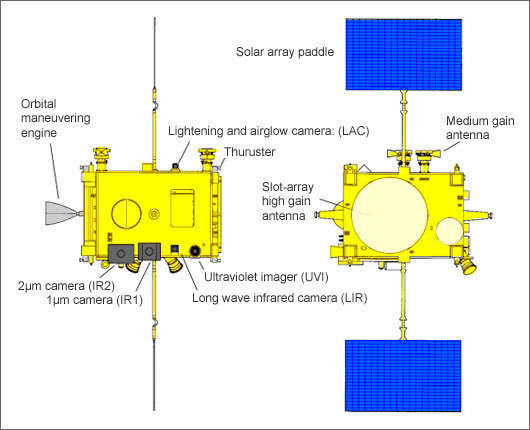Emily Lakdawalla • Dec 10, 2010
Akatsuki update: Failure to enter orbit due to insufficient fuel pressure
An English-language article in the December 11 Yomiuri Shimbun (further disseminated by the Associated Press) summarizes the news from the Akatsuki press briefing held at 11:00 December 10 JST (last night, my time). It's succinct and clear so I'm reposting it here. If you go to the Yomiuri Shimbun site there is a good collection of links to other articles in English that summarize the previous developments. I'm afraid that this is mostly bad news.
The sudden loss of balance that prevented the Akatsuki space probe from going into orbit around Venus on Tuesday was due to a sudden drop in engine power likely caused by an insufficient supply of fuel, the Japan Aerospace Exploration Agency said Friday.
As the ceramic nozzle on Akatsuki's engine is believed to have been damaged, JAXA may find it difficult to put the probe into orbit around Venus when it comes close to the planet six years from now.
The agency analyzed data recorded while Akatsuki's orbit maneuvering engine was retrofiring to reduce the probe's velocity so it would be drawn by Venus' gravity into orbit around the planet. The data indicated the flow of fuel and changes in temperature around the engine.
It showed the pressure in the fuel tank began to drop immediately after the retrofiring, which caused the engine propulsion to slow.
The probe lost its balance two minutes 23 seconds after starting the maneuver, as engine propulsion had drastically weakened.
It remains unknown what caused the sudden slowdown in propulsion, but JAXA officials suspect problems with the engine burn, resulting from a lack of fuel, may have damaged the engine nozzle.
The fuel tank is supposed to maintain its internal pressure while the engine is being fired by injecting helium gas as fuel is pushed out. But the pressure in Akatsuki's tank is believed to have weakened as fuel was gradually consumed, making it impossible for the tank to properly supply fuel to the engine.
JAXA officials suspect there were faults in the pipes and valves used to inject helium.
When the space probe Nozomi was launched in 1998, it failed to fire its engine due to problems with the injection of helium, which led to lower pressure in the fuel tank.Here is some more detail on what was said at the press briefing; this information was originally Tweeted in Japanese by @ots_min and @ShinyaMatsuura and translated for me by @hee913758. I am very grateful for the effort that went in to this translation! I don't get quite all of it but copy it here anyway in case it's useful to people.
@ots_min
- Correction: Akatsuki lose its balance after 152 seconds' burn, not 143 seconds.
- One more correction: The angle was 42 degrees, not 360 degrees.
- For 0 to 152sec: the pressure of the fuel tank was dropping.
- And the acceleration was also dropping for 0 to 152sec.
- After 152sec,acceleration dropped suddenly.0.8 to 0.5. And recovered a little.
- As for 0 to 152sec, the acceleration was slowly dropping, which was different from what we expected.
- After 158sec, its attitude-stabilization mode switched from RCS (reaction control system) to RW (reaction wheels).
- The mode automatically switched, under Akatsuki's autonomous control.
- Akatsuki went in this mode for a while, but it couldn't recover. So it switched to safe mode.
- After going into safe mode, the probe spun up and stabilized.
- When the attitude stabilization mode switched to RW, Akatsuki shut the valve of liquid chemicals.
- This caused interruption of combustion.
- Pressure in the fuel tank was controlled with helium.
- The drop in fuel pressure was beyond our expectation.
- NHK TV asked: What caused the drop in pressure?
- A pipe in the (gas-pressurized device?) could be choked, or something interrupted the flow of fuel.
- But the drop in pressure and the drop in the acceleration have no direct relation to each other. We have to analyze what could mediate between the two.
- Question: Was the drop in pressure due to the lack of fuel?
- Answer from Nakamura: Compared to the fixed mixing ratio, the amount of fuel was slightly less than expected. We're going to analyze the details.
- We're going to experiment on the ground to see what would happen with several different mixing ratios.
@ShinyaMatsuura (from his recap of the failure timeline on this site)
- 0 sec: Maneuver started. The pressure of fuel tank and acceleration have been dropping slowly at the same time until 152 sec.
- 152 sec: Abruptly acceleration dropped hard and lost its balance 42 degrees (X-axis orientation).
- 158 sec: Attitude stabilizing mode by RCS switched to Reaction Wheel. And the valve of liquid chemicals (oxidizer) shut (an emergency action), so the engine stopped.
- 375 sec: RW switched to Safe hold mode
- During the event, the pressure of the fuel tank should have been maintained by pressurizing with helium.
- One of the conceivable reasons why the pressure went dropping is the blockage of the pipe to the fuel tank.
Support our core enterprises
Your support powers our mission to explore worlds, find life, and defend Earth. You make all the difference when you make a gift. Give today!
Donate

 Explore Worlds
Explore Worlds Find Life
Find Life Defend Earth
Defend Earth


